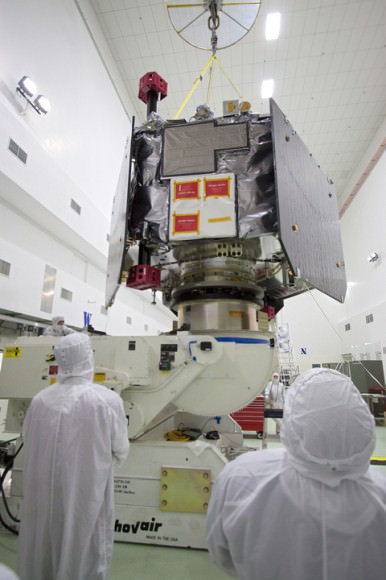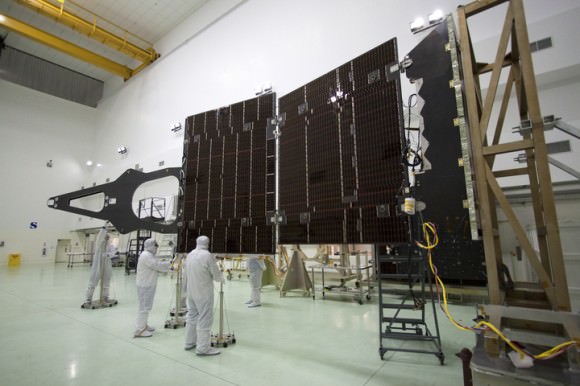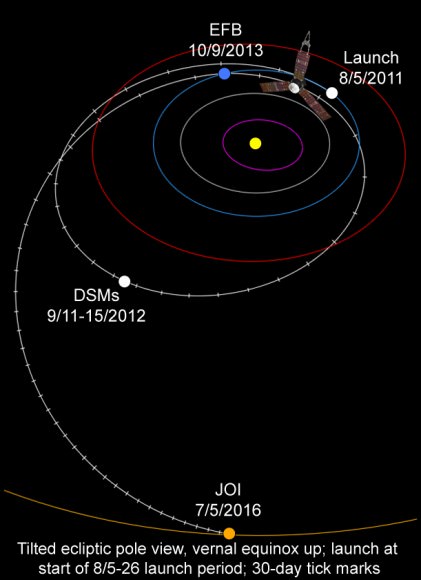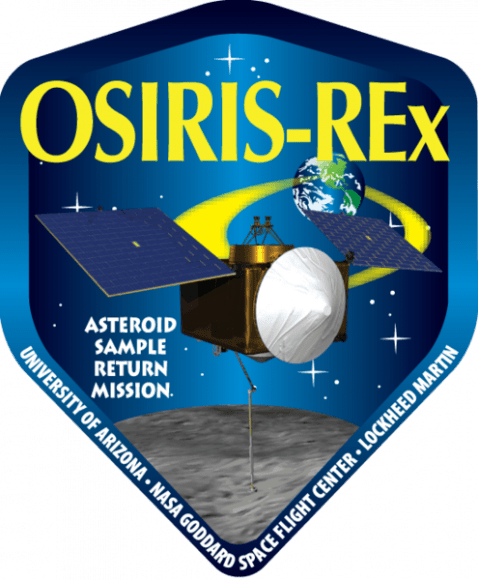Earth is a strange world. A warm, rocky planet covered with oceans of liquid water. This strangeness is central to life on Earth, but it has been a longstanding puzzle for astronomers. Just why is our planet wet while other terrestrial worlds are dry? Where did all of Earth’s water come from?
Continue reading “Mapping the Interiors of Meteorites to Learn how Earth got its Water”OSIRIS-REx Asteroid Sampler Enters Final Assembly
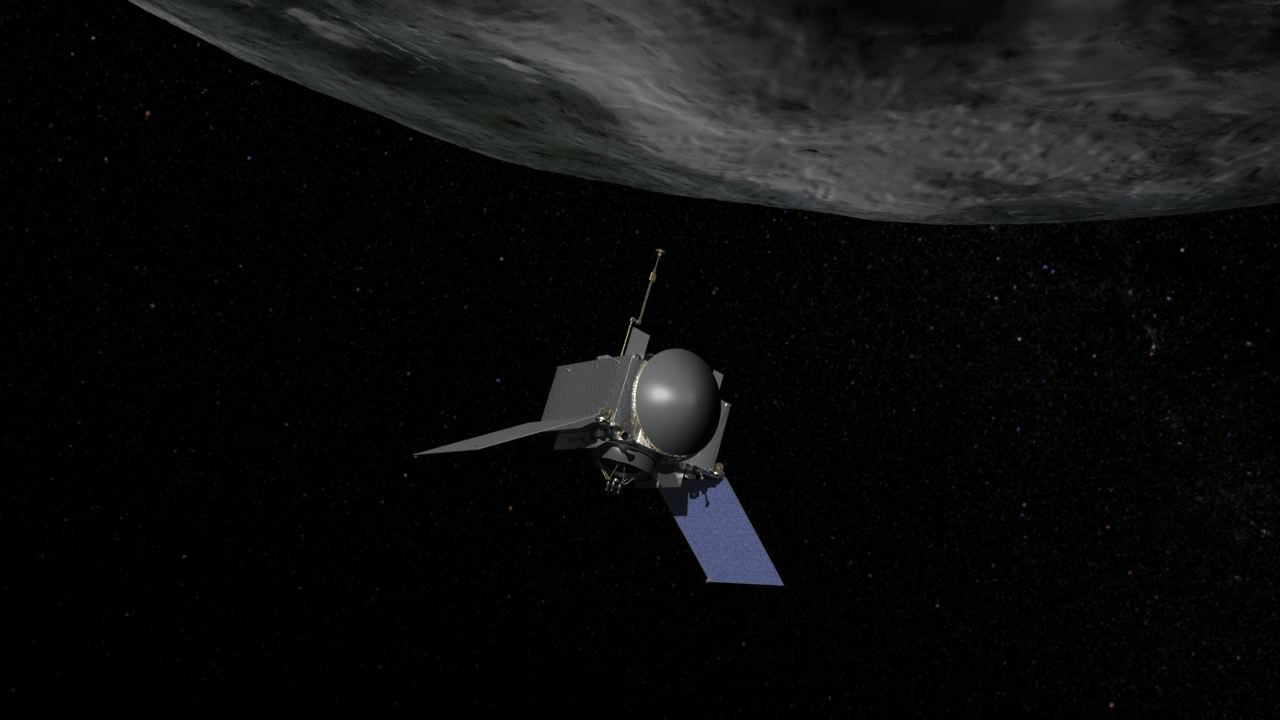
OSIRIS-Rex, NASA’s first ever spacecraft designed to collect and retrieve pristine samples of an asteroid for return to Earth has entered its final assembly phase.
Approximately 17 months from now, OSIRIS-REx is slated to launch in the fall of 2016 and visit asteroid Bennu, a carbon-rich asteroid.
Bennu is a near-Earth asteroid and was selected for the sample return mission because it “could hold clues to the origin of the solar system and host organic molecules that may have seeded life on Earth,” says NASA.
The spacecraft is equipped with a suite of five science instruments to remotely study the 492 meter meter wide asteroid.
Eventually it will gather rocks and soil and bring at least a 60-gram (2.1-ounce) sample back to Earth in 2023 for study by researchers here with all the most sophisticated science instruments available.
The precious sample would land arrive at Utah’s Test and Training Range in a sample return canister similar to the one for the Stardust spacecraft.
The OSIRIS-REx – which stands for Origins, Spectral Interpretation, Resource Identification, Security, Regolith Explorer – spacecraft passed a critical decision milestone on the road to launch and has been officially authorized by NASA to transition into this next mission phase.
The decision meeting to give the go ahead for final assembly was held at NASA Headquarters in Washington on March 30 and was chaired by NASA’s Science Mission Directorate, led by former astronaut John Grunsfeld who was the lead spacewalker on the final shuttle servicing mission to the Hubble Space Telescope in 2009.
“This is an exciting time for the OSIRIS-REx team,” said Dante Lauretta, principal investigator for OSIRIS-Rex at the University of Arizona, Tucson, in a stetement.
“After almost four years of intense design efforts, we are now proceeding with the start of flight system assembly. I am grateful for the hard work and team effort required to get us to this point.”
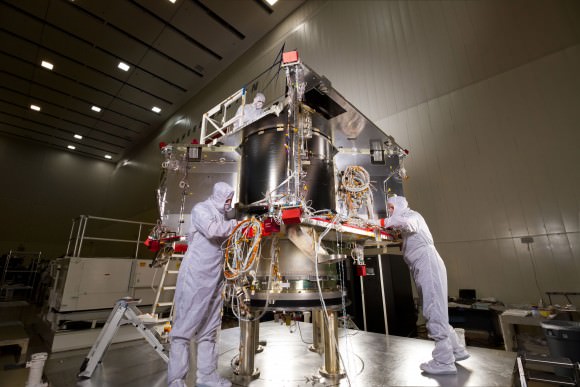
The transition to the next phase known as ATLO (assembly, test and launch operations) is critical for the program because it is when the spacecraft physically comes together, says Lockheed Martin, prime contractor for OSIRIS-REx. Lockheed is building OSIRIS-Rex in their Denver assembly facility.
“ATLO is a turning point in the progress of our mission. After almost four years of intense design efforts, we are now starting flight system assembly and integration of the science instruments,” noted Lauretta.
Over the next six months, technicians will install on the spacecraft structure its many subsystems, including avionics, power, telecomm, mechanisms, thermal systems, and guidance, navigation and control, according to NASA.
“Building a spacecraft that will bring back samples from an asteroid is a unique opportunity,” said Rich Kuhns, OSIRIS-REx program manager at Lockheed Martin Space Systems, in a statement.
“We can feel the momentum to launch building. We’re installing the electronics in the next few weeks and shortly after we’ll power-on the spacecraft for the first time.”
OSIRIS-REx is scheduled for launch in September 2016 from Cape Canaveral Air Force Station in Florida aboard a United Launch Alliance Atlas V 411 rocket, which includes a 4-meter diameter payload fairing and one solid rocket motor. Only three Atlas V’s have been launched in this configuration.
“In just over 500 days, we will begin our seven-year journey to Bennu and back. This is an exciting time,” said Lauretta.
The spacecraft will reach Bennu in 2018 and return a sample to Earth in 2023.
Bennu is an unchanged remnant from the collapse of the solar nebula and birth of our solar system some 4.5 billion years ago, little altered over time.
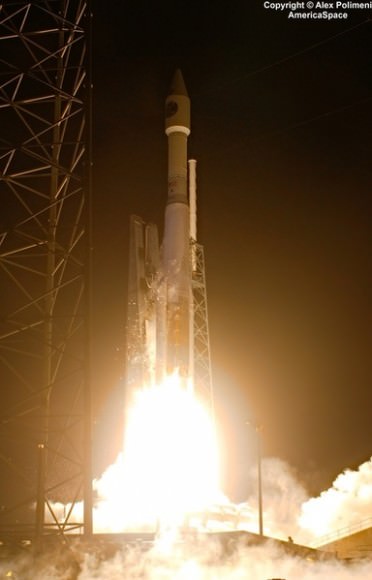
Significant progress in spacecraft assembly has already been accomplished at Lockheed’s Denver manufacturing facility.
“The spacecraft structure has been integrated with the propellant tank and propulsion system and is ready to begin system integration in the Lockheed Martin highbay,” said Mike Donnelly, OSIRIS-REx project manager at NASA’s Goddard Space Flight Center in Greenbelt, Maryland, in a statement.
“The payload suite of cameras and sensors is well into its environmental test phase and will be delivered later this summer/fall.”
OSIRIS-REx is the third mission in NASA’s New Frontiers Program, following New Horizons to Pluto and Juno to Jupiter, which also launched on Atlas V rockets.
The most recent Atlas V launched NASA’s MMS quartet of Earth orbiting science probes on March 12, 2015.
NASA’s Goddard Space Flight Center in Greenbelt, Maryland, is responsible for overall mission management.
OSIRIS-REx complements NASA’s Asteroid Initiative – including the Asteroid Redirect Mission (ARM) which is a robotic spacecraft mission aimed at capturing a surface boulder from a different near-Earth asteroid and moving it into a stable lunar orbit for eventual up close sample collection by astronauts launched in NASA’s new Orion spacecraft. Orion will launch atop NASA’s new SLS heavy lift booster concurrently under development.
Stay tuned here for Ken’s continuing Earth and planetary science and human spaceflight news.
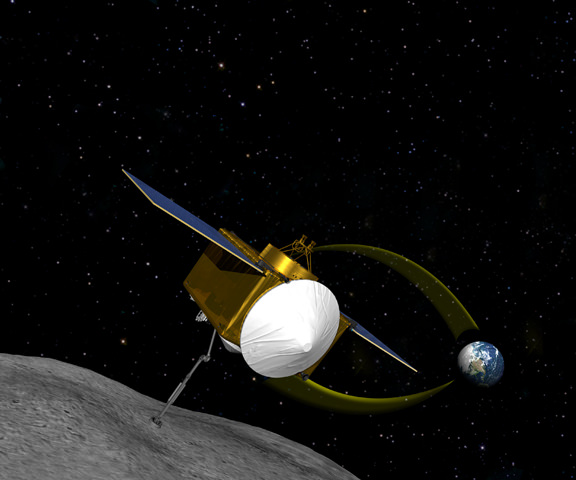

First Image Captured by NASAs Jupiter bound Juno; Earth – Moon Portrait
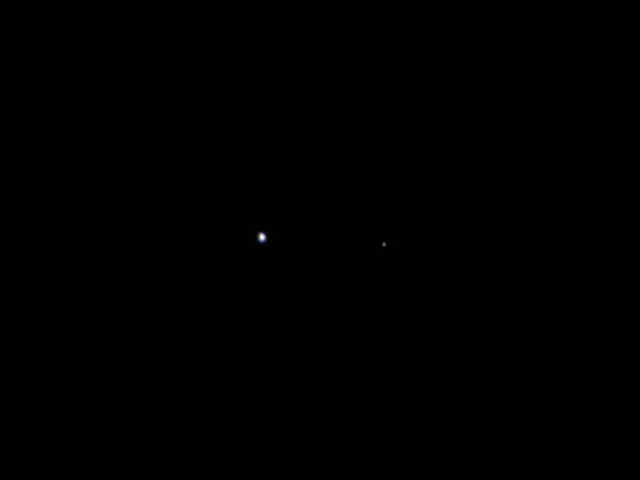
[/caption]
NASA’s solar powered Jupiter bound Juno orbiter has captured her first image – a beautiful portrait of the Earth & Moon – since the probe blasted off from the home planet.
Juno lifted off 25 days ago at 12: 25 p.m. on August 5 from Space Launch Complex 41 at Cape Canaveral Air Force Station in Florida. The spacecraft snapped the portrait with the onboard JunoCam camera on August 26 after journeying some 6 million miles (9.66 million km) from Earth and while traveling at a velocity of 77,600 miles per hour (124,900 kilometers per hour) relative to the sun.
“The image of the Earth Moon system is a rather unique perspective that we can get only by stepping outside of our home planet,” said Scott Bolton, Juno principal investigator, in an exclusive interview with Universe Today. Bolton is from the Southwest Research Institute in San Antonio.
“On our way to Jupiter, we’ve looked back at home and managed to take this amazing image.”
“Earth looking much like any other planet or star from a distance is glorious as this somewhat average looking “star” is home to all of humanity. Our companion, the moon, so beautiful and important to us, stands out even less.”
“We appear almost average and inconspicuous, yet all of our history originates here. It makes one wonder just how many other planets or solar systems might contain life like ours,” Bolton told me.
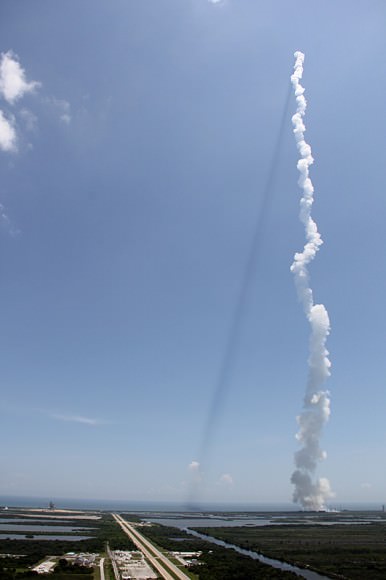
The Juno team commanded the probe to take the image as part of the checkout phase of the vehicles instruments and subsystems.
“The JunoCam instrument turn on and check out were planned activities. The instrument is working great and in fact, all the instruments that we’ve turned on thus far have been working great,” Bolton added.
So far the spacecraft is in excellent health and the team has completed the checkout of the Waves instrument and its two Flux Gate Magnetometer sensors and deployment of its V-shaped electric dipole antenna.
“We have a couple more instruments still to do,” Bolton noted.
The team reports that Juno also performed its first precession, or reorientation maneuver, using its thrusters and that the first trajectory control maneuver (TCM-1) was cancelled as unnecessary because of the extremely accurate targeting provided by the Atlas V rocket.
The portrait shot is actually not Juno’s last photo of her home.
The 8000 pound (3,600 kilogram) probe will fly by Earth once more on October 9, 2013 for a gravity assisted speed boost of 16,330 MPH (7.3 km/sec) to accelerate Juno past the asteroid belt on its long journey to the Jovian system.

JunoCam will collect new photos and the other science instruments will make measurements as Juno cartwheels past Earth during the slingshot to Jupiter.
Juno is on a 5 year and 1.7 Billion mile (2.8 Billion km) trek to the largest planet in our solar system. When she arrives at Jupiter on July 4, 2016, Juno will become the first polar orbiting spacecraft at the gas giant.
During a one year science mission – entailing 33 orbits lasting 11 days each – the probe will plunge to within about 3000 miles (5000 km) of the turbulent cloud tops and collect unprecedented new data that will unveil the hidden inner secrets of Jupiter’s genesis and evolution.
The goal is to find out more about the planets origins, interior structure and atmosphere, observe the aurora, map the intense magnetic field and investigate the existence of a solid planetary core.
“This is a remarkable sight people get to see all too rarely,” said Bolton in a NASA statement about the Earth-Moon photo. “This view of our planet shows how Earth looks from the outside, illustrating a special perspective of our role and place in the universe. We see a humbling yet beautiful view of ourselves.”
NASA’s Jet Propulsion Laboratory manages the Juno mission. The spacecraft was designed and built by Lockheed Martin Space Systems, Denver.
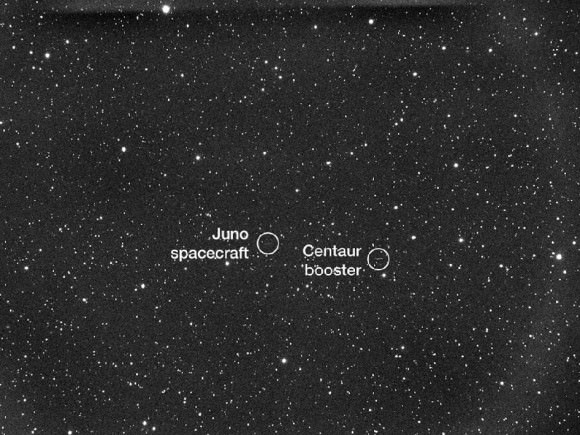
NASA's Juno spacecraft and its spent Centaur upper rocket stage are captured in this telescope view as they move across the field of stars. The five-minute, timed exposure was acquired on Aug. 5 11:18pm Eastern time (Aug. 6 at 3:18 UTC) when Juno was at a distance of about 195,000 miles (314,000 kilometers) from Earth. The images were taken remotely by amateur astronomer Scott Ferguson using Global Rent-a-Scope's GRAS-016 Takahashi Widefield Refractor, which is located in Nerpio, Spain. Credit: Scott Ferguson
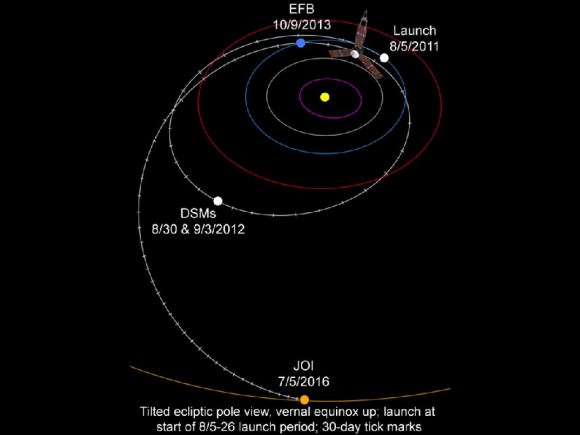
This graphic shows Juno's trajectory, or flight path, from Earth to Jupiter. The spacecraft travels around the Sun, to a point beyond the orbit of Mars where it fires its main engine a couple of times. These deep space maneuvers set up the Earth flyby maneuver that occurs approximately two years after launch. The Earth flyby gives Juno the boost in velocity it needs to coast all the way to Jupiter. Juno arrives at Jupiter in July 2016. Credit: NASA/JPL-Caltech
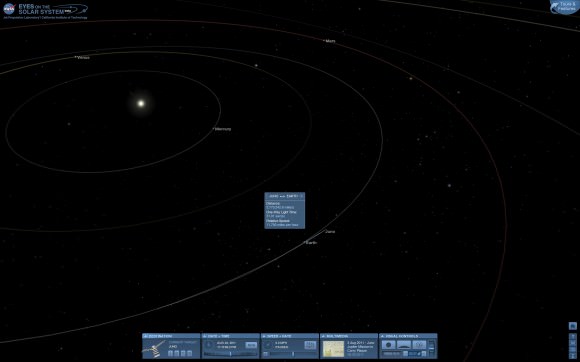
Read my continuing features about Juno
Juno Blasts off on Science Trek to Discover Jupiter’s Genesis
Juno Jupiter Orbiter poised at Launch Pad for Aug. 5 Blastoff
JUNO Orbiter Mated to Mightiest Atlas rocket for Aug. 5 Blastoff to Jupiter
Solar Powered Jupiter bound JUNO lands at Kennedy Space Center
Juno Blasts off on Science Trek to Discover Jupiter’s Genesis
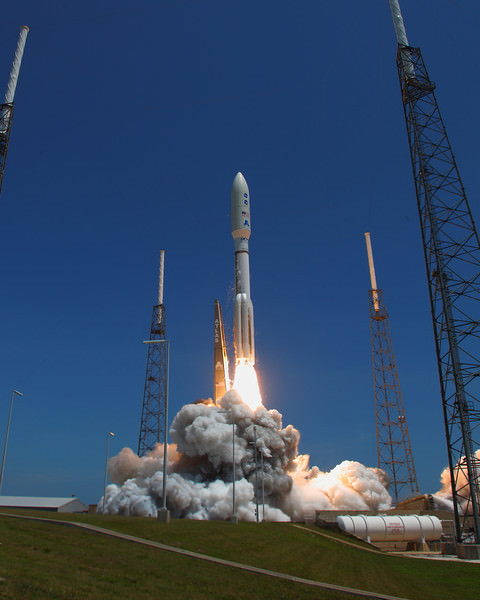
[/caption]
NASA’s solar powered Juno spacecraft blasted off today (Aug.5)from Cape Canaveral today to begin a 2.8 billion kilometer science trek to discover the genesis of Jupiter hidden deep inside the planet’s interior.
Upon arrival at Jupiter in July 2016, JUNO will fire its braking rockets and go into polar orbit and circle the planet 33 times over about one year. The goal is to find out more about the planets origins, interior structure and atmosphere, observe the aurora, map the intense magnetic field and investigate the existence of a solid planetary core.
The spacecraft is healthy and the solar panels successfully deployed.
Check out the photo album of Juno’s launch from the Universe Today team of Alan Walters and Ken Kremer.
“Jupiter is the Rosetta Stone of our solar system,” said Scott Bolton, Juno’s principal investigator from the Southwest Research Institute in San Antonio. “It is by far the oldest planet, contains more material than all the other planets, asteroids and comets combined and carries deep inside it the story of not only the solar system but of us. Juno is going there as our emissary — to interpret what Jupiter has to say.”
Juno was launched atop a powerful Atlas V rocket augmented by 5 solid rocket boosters – built by United Launch Alliance
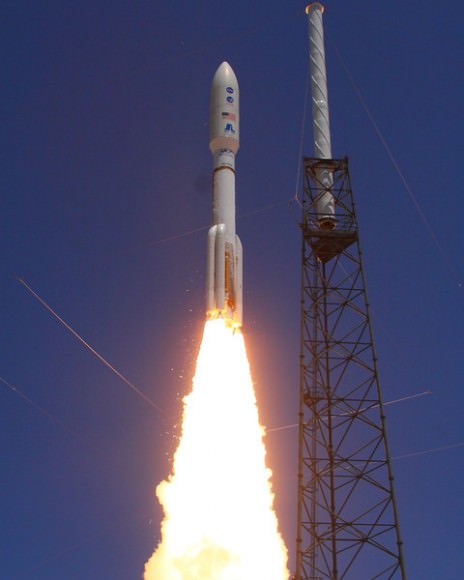
“Today, with the launch of the Juno spacecraft, NASA began a journey to yet another new frontier,” NASA Administrator Charles Bolden said. “The future of exploration includes cutting-edge science like this to help us better understand our solar system and an ever-increasing array of challenging destinations.”
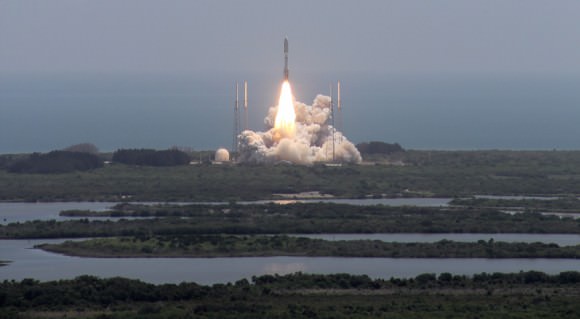
Atlas V liftoff with JUNO to Jupiter on Aug. 5 from Cape Canaveral Air Force Station. Credit: Ken Kremer
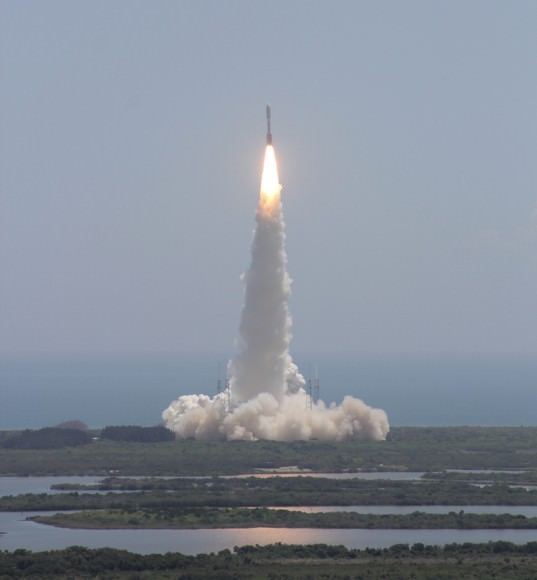
Atlas V liftoff with JUNO to Jupiter on Aug. 5 from Cape Canaveral Air Force Station. Credit: Ken Kremer (kenkremer.com)
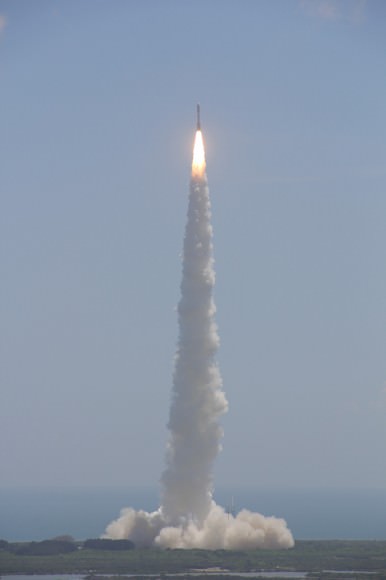
JUNO blasts off for Jupiter on Aug. 5 atop an Atlas V rocket from Cape Canaveral Air Force Station at 12:25 p.m. EDT.
Credit: Ken Kremer (kenkremer.com)
Send Ken your Juno launch photos to post at Universe Today
Read my continuing features about Juno
Juno Jupiter Orbiter poised at Launch Pad for Aug. 5 Blastoff
JUNO Orbiter Mated to Mightiest Atlas rocket for Aug. 5 Blastoff to Jupiter
Solar Powered Jupiter bound JUNO lands at Kennedy Space Center
NASA Selects OSIRIS-REx as first US Asteroid Sampling Mission
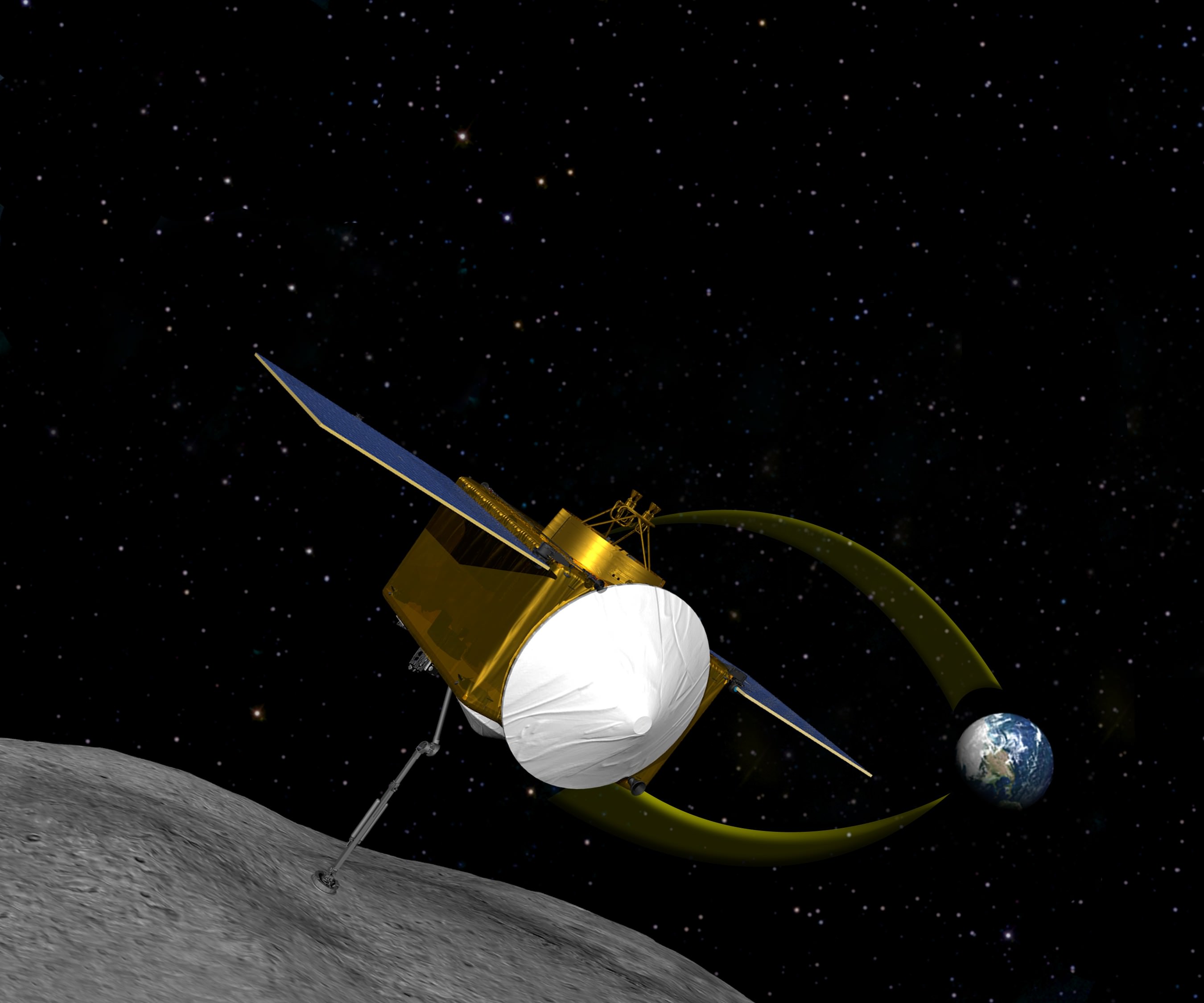
[/caption]
NASA officials announced the selection of OSIRIS-Rex as the next US robotic planetary science mission and which will pave the way for an eventual manned mission to an asteroid. OSIRIS-Rex will be the first US mission to collect and return samples of an asteroid to Earth.
OSIRIS-Rex is planned for launch to the near Earth asteroid designated as 1999 RQ36 in September 2016 and will return up to four pounds of prisitine asteroidal material to Earth in 2023. The precious sample would land arrive at Utah’s Test and Training Range in a sample return canister similar to the one for the Stardust spacecraft.
“We are absolutely delighted to announce the selection of OSIRIS-Rex,” said Jim Green, director of NASA’s Planetary Science Division, at a briefing for reporters.
“This asteroid is a time capsule from the birth of our solar system and ushers in a new era of planetary exploration. The knowledge from the mission also will help us to develop methods to better track the orbits of asteroids.”
OSIRIS-Rex is the acronym for Origins-Spectral Interpretation-Resource Identification-Security-Regolith Explorer.
The asteroid is an unchanged remnant from the collapse of the solar nebula and birth of our solar system some 4.5 billion years ago, little altered over time.
Asteroid 1999 RQ36 is likely rich in carbon, the key constituent of organic molecules and one of the building blocks of life. Organic molecules have been found in meteorite and comet samples, which indicates that some of life’s ingredients can be created in space.
The science team will determine if organics also are present on RQ36.
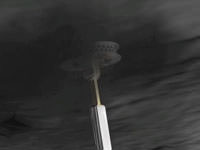
Asteroids like 1999 RQ36 may have seeded Earth billions of years ago with organic molecules that are the building blocks of life and perhaps eventually led to living organisms. Samples from the asteroids may help scientists unlock the mysteries of the origin of life on Earth.
Three years after launch, OSIRIS-Rex would arrive at Asteroid 1999 RQ36 in 2020 and study the 1900 foot wide space rock in detail for at least six months of comprehensive surface examinations with four science instruments.
The science team will also use the time – perhaps up to one year – to look for the optimal place to touch the surface and collect a sample of at least two ounces of surface material with a robotic arm.
“We are bringing back what we believe is the type of material that led to the building blocks of life, that led to us,” said Michael Drake, principal investigator of the OSIRIS-REx mission from the University of Arizona.

Credit: NASA/Goddard/University of Arizona
“OSIRIS-REx will explore our past and help determine our destiny,” said Drake. “It will return samples of pristine organic material that scientists think might have seeded the sterile early Earth with the building blocks that led to life. Such samples do not currently exist on Earth. OSIRIS-REx will also provide the knowledge that will guide humanity in deflecting any future asteroid that could collide with Earth, allowing humanity to avoid the fate of the dinosaurs.”
The small asteroid RQ36 has also attracted interest because there is a 1-in-1,800 chance of impacting the Earth in the year 2182.
Drake added that the team will carefully practice the sample collection before conducting the actual retrieval of a surface material of a mixture of soil and rocks with a pogo stick like device. He said it would be more like “kissing” the surface than a actual landing of the spacecraft.
The sampling device at the end of the robot arm looks like a car air filter. It will haul in the pristine regolith into the sample acquisition mechanism within 5 seconds in a “touch and go” maneuver as the spacecraft slowly descends at 0.1 m/sec. Up to 3 attempts are possible.
Check the sampling sequence video below.
Because the samples are expected to possess organic molecules, they will be subject to stringent planetary protection protocols. The OSIRIS-REx sample capsule will be stored for analysis at a special curation facility at NASA’s Johnson Space Center in Houston. By returning the asteroid samples to Earth, they can be studied by the most advanced science equipment available.
“I think we’ll get some much needed info on the composition and physical properties of asteroid surface material. I’m particularly interested in water content for future resource use. The photos should be spectacular,” said former Astronaut Tom Jones in exclusive comments for Universe Today.
“This is a critical step in meeting the objectives outlined by President Obama to extend our reach beyond low-Earth orbit and explore into deep space,” said NASA Administrator Charlie Bolden in a statement. “It’s robotic missions like these that will pave the way for future human space missions to an asteroid and other deep space destinations.”
When the mission is complete, the spacecraft is expected to have sufficient fuel reserves to be retargeted to a new destination according to Michael Drake.
OSIRIS-Rex is expected to cost $800 million according to Jim Green, minus the cost of the launch vehicle which he said has not yet been determined. This is the third mission in NASA’s New Frontiers Program following the Pluto-Charon mission and the Juno Jupiter Orbiter.
Lockheed Martin Space Systems in Denver is building the spacecraft. Overall mission management will be provided by NASA’s Goddard Space Flight Center in Greenbelt, Md.
Solar Powered Jupiter bound JUNO lands at Kennedy Space Center for blastoff
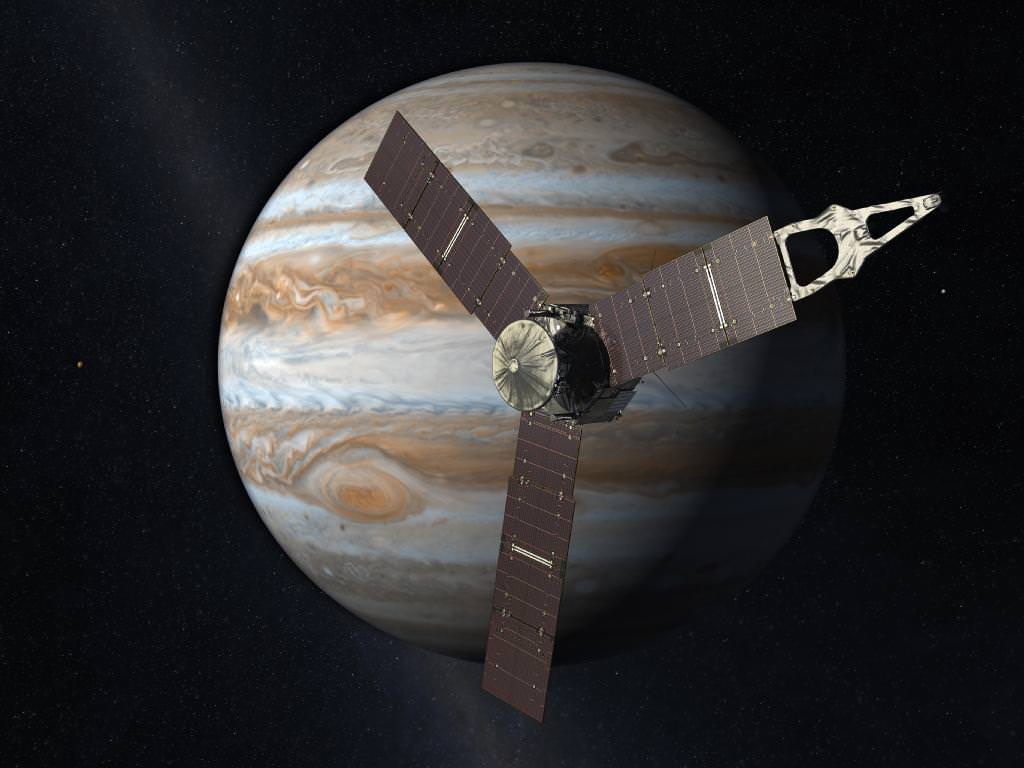
[/caption]
Juno, NASA’s next big mission bound for the outer planets, has arrived at the Kennedy Space Center to kick off the final leg of launch preparations in anticipation of blastoff for Jupiter this summer.
The huge solar-powered Juno spacecraft will skim to within 4800 kilometers (3000 miles) of the cloud tops of Jupiter to study the origin and evolution of our solar system’s largest planet. Understanding the mechanism of how Jupiter formed will lead to a better understanding of the origin of planetary systems around other stars throughout our galaxy.
Juno will be spinning like a windmill as it fly’s in a highly elliptical polar orbit and investigates the gas giant’s origins, structure, atmosphere and magnetosphere with a suite of nine science instruments.
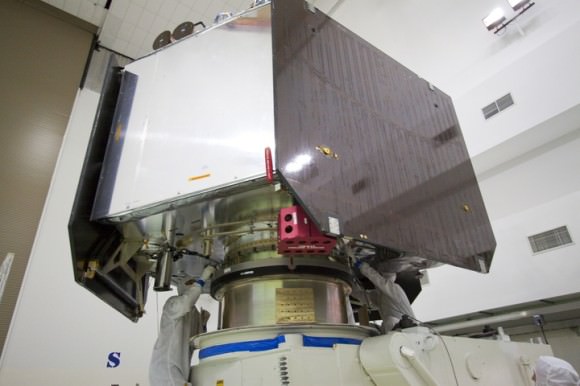
During the five year cruise to Jupiter, the 3,600 kilogram probe will fly by Earth once in 2013 to pick up speed and accelerate Juno past the asteroid belt on its long journey to the Jovian system where it arrives in July 2016.
Juno will orbit Jupiter 33 times and search for the existence of a solid planetary core, map Jupiter’s intense magnetic field, measure the amount of water and ammonia in the deep atmosphere, and observe the planet’s auroras.
The mission will provide the first detailed glimpse of Jupiter’s poles and is set to last approximately one year. The elliptical orbit will allow Juno to avoid most of Jupiter’s harsh radiation regions that can severely damage the spacecraft systems.
Juno was designed and built by Lockheed Martin Space Systems, Denver, and air shipped in a protective shipping container inside the belly of a U.S. Air Force C-17 Globemaster cargo jet to the Astrotech payload processing facility in Titusville, Fla.
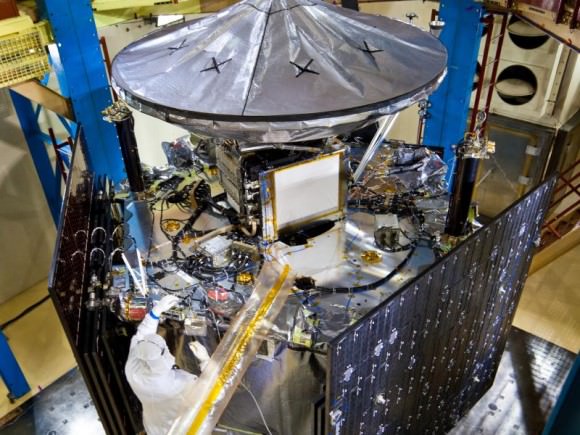
This week the spacecraft begins about four months of final functional testing and integration inside the climate controlled clean room and undergoes a thorough verification that all its systems are healthy. Other processing work before launch includes attachment of the long magnetometer boom and solar arrays which arrived earlier.
Juno is the first solar powered probe to be launched to the outer planets and operate at such a great distance from the sun. Since Jupiter receives 25 times less sunlight than Earth, Juno will carry three giant solar panels, each spanning more than 20 meters (66 feet) in length. They will remain continuously in sunlight from the time they are unfurled after launch through the end of the mission.
“The Juno spacecraft and the team have come a long way since this project was first conceived in 2003,” said Scott Bolton, Juno’s principal investigator, based at Southwest Research Institute in San Antonio, in a statement. “We’re only a few months away from a mission of discovery that could very well rewrite the books on not only how Jupiter was born, but how our solar system came into being.”
Juno is slated to launch aboard the most powerful version of the Atlas V rocket – augmented by 5 solid rocket boosters – from Cape Canaveral, Fla. on August 5. The launch window extends through August 26. Juno is the second mission in NASA’s New Frontiers program.
NASA’s Mars Curiosity Rover will follow Juno to the Atlas launch pad, and is scheduled to liftoff in late November 2011. Read my stories about Curiosity here and here.
Because of cuts to NASA’s budget by politicians in Washington, the long hoped for mission to investigate the Jovian moon Europa may be axed, along with other high priority science missions. Europa may harbor subsurface oceans of liquid water and is a prime target in NASA’s search for life beyond Earth.
